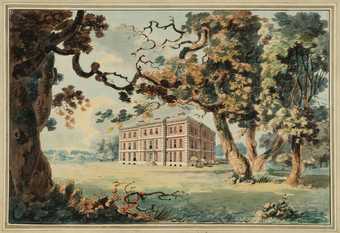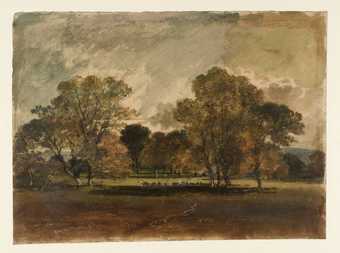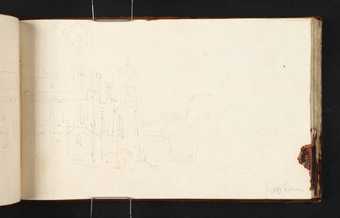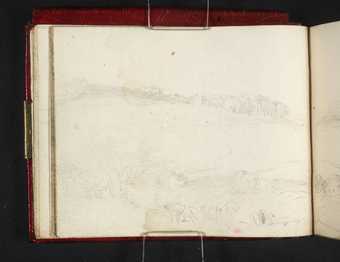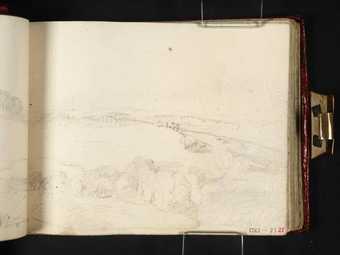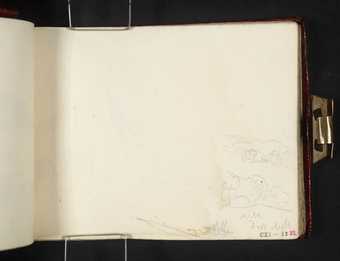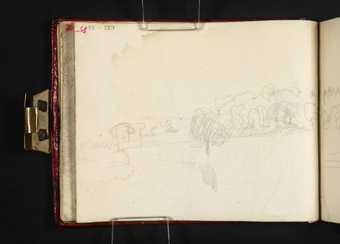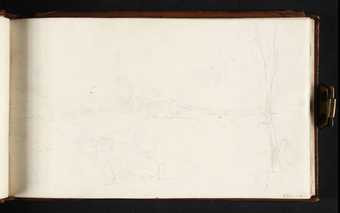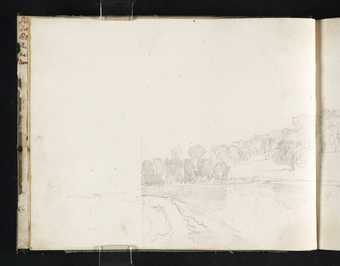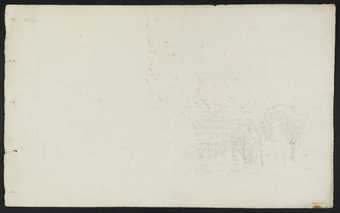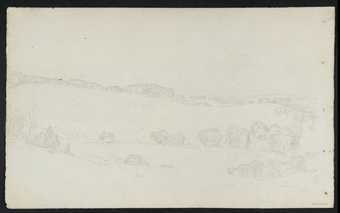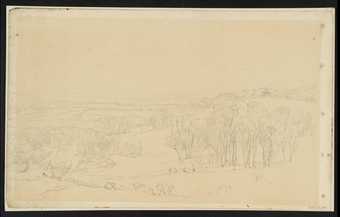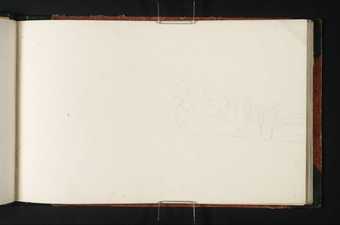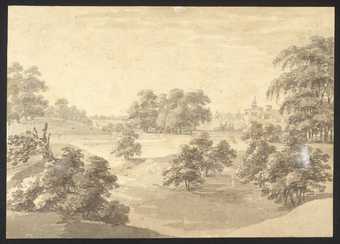
In Tate Britain
Prints and Drawings Room
View by appointment- Artist
- Joseph Mallord William Turner 1775–1851
- Medium
- Oil and watercolour on paper
- Dimensions
- Support: 270 × 375 mm
- Collection
- Tate
- Acquisition
- Accepted by the nation as part of the Turner Bequest 1856
- Reference
- D05957
Turner Bequest XCV a D
Display caption
As far as we know, Turner first experimented with oil sketching
from nature in Kent in 1799; his friend, Joseph Farington, recorded in his diary that he had been there 'painting from Beech Trees'. His tree studies, of which two are shown here, were made at Knockholt and in Chevening Park nearby. In them, Turner experimented with new combinations of media: mixing oil and watercolour on paper first prepared
with a sizing solution.
Gallery label, September 2004
Does this text contain inaccurate information or language that you feel we should improve or change? We would like to hear from you.
Technique and condition
Catalogue entry
[from] Nos. 35a-j: Knockholt and Other Kent Sketches c.
1799–1801
THESE sketches in oil on paper fall into two groups. The first edition of this catalogue only included six sketches in the British Museum, all associated by Finberg with Turner's visits to his friend W.F. Wells at Knockholt in 1806; these were catalogued as Nos. 154–9 and are here renumbered Nos. 35e-j (a further work associated by Finberg with this group but seemingly distinct from it is here catalogued as No. 35 [D05960]). According to Finberg, confirmed by Andrew Wilton in the case of Nos. 35e [D05954] and 35g [D05957], five of these bear inscriptions linking them with Knockholt or other Kent subjects and the remaining example, No. 35j [D05959], is similar in general treatment. Since the first edition of our catalogue four further Kent sketches have turned up, distinct in style and, in at least three cases, subject; these are catalogued as Nos. 35a–d.
Turner seems to have known the landscape artist and drawing master William Frederick Wells (1762–1836) by 1800 if not earlier, and it is no longer necessary to associate this group of sketches with the visit on which, according to Wells' daughter Clara, Mrs Wheeler, Wells persuaded Turner to start work on the Liber Studiorum and which she states took place in October 1806 (letter of 27 July 1853, reprinted in W. G. Rawlinson, Turner's Liber Studiorum 1906, pp. xii–xiii). In the first edition of this catalogue it was nevertheless argued that these works dated from c. 1805–6 on the grounds that the park scenes, Nos. 35g, 35h and 35i, were close to such watercolours as the Thames views in the ‘Thames from Reading to Walton’ sketchbook of c. 1806 (XCV-34, repr. in colour, Wilkinson 1974, p. 77, and in exh. cat., B.M. 1975–6, p. 40 no. 34), while the interiors were thought to reflect the same interest as the Country Blacksmith disputing upon the Price of Iron, exhibited in 1807 (No. 68; see also the wash drawing repr. exh. cat., B.M. 1975–6, p. 41 no. 36, and Pembury Mill, Kent, published in the Liber Studiorum, R. 12, on 10 June 1808 and repr. Finberg 1924, p. 47). However, Andrew Wilton has convincingly dated the works earlier, partly because of their experimental use of mixed media which is also found in works of c. 1799–1800, and Miklos Rajnai has supported this earlier dating. An early dating has also been strengthened by the recent discovery of two oil sketches of beechwoods, Nos. 35a and 35b.
When these newly discovered sketches of beechwoods now in the Fitzwilliam Museum were first published by Miklos Rajnai they were associated with Farington's note in his Diary for 30 October 1799, ‘Turner called. Has been in Kent painting from Beech Trees.’ The autumnal colouring of the foliage in these sketches fits in well with the date of this entry. In addition, Rajnai releated the sketches to a watercolour of Peasants Seated Round a Camp Fire in the ‘Wilson’ sketchbook which contains notes in Turner's writing mentioning dates in November and December 1797 (XXXVII-21). Moreover, Mr. Derek Chittock has discovered that Turner not only knew W.F. Wells at Knockholt but also Henry Fly, curate at St. Katharine's, Knockholt from 1791–1813, so Turner could have stayed with him while making these sketches.
The sketch of A Beech Wood in the Fogg Art Museum (No. 35c), hitherto unnoticed by the compilers, is very similar to these two works, as is, to judge from the old reproduction, Knockholt Park, Kent (No. 35d), now untraced but which seems to be on a sheet of paper of the same size. If they are the product of a visit to Kent in 1799 then they become the earliest known examples of Turner sketching in oils out of doors. John Gage suggests that it was perhaps Turner's friendship with the painter William Delamotte (1775–1863) that encouraged Turner to follow the latter's practice of making oil sketches on the spot, and he also draws attention to similarities with certain early pictures by Gainsborough.
However, recent research by Derek Chittock (verbal communication to Evelyn Joll) has shown that Wells did not move into his cottage at Knockholt until 1801, though he may have visited the village earlier. The inscription on No. 35e [D05954], ‘Wells' Kitchen Knockholt’, implies residence, and it seems therefore as if this group of works, unlike Nos. 35a–35d, cannot date from earlier than 1801. Arthur Marks has made the very tentative suggestion that the two interiors, Nos. 35e [D05954] and 35f [D05956], may have been influenced by Wilkie's success with domestic interiors, beginning with The Village Politicians at the Royal Academy in 1806, but the evidence for an earlier dating now seems more convincing.
Moreover, Robert Yardley has recently discovered a watercolour version of No. 35a. This measures 10 3/8 × 7 1/2 in. (26·3× 19 cm.) and still belongs to the descendants of W. F. Wells. It has been torn in half at some time and is now rather crudely pasted together. There is an accompanying note which reads ‘Retrieved from waste paper basket by Clarissa Anne Wells 1787–1883’. The compilers have not seen the original but, from a photograph, it looks perfectly genuine. As Wells did not move to Knockholt until 1801 this would mean that if, as seems the case, the watercolour and oil sketches were done at the same time, and if Turner himself tore up the watercolour because he was dissatisfied with it, the dating of all these works would have to be put back to 1801 at the earliest, as is apparently the case with the group of sketches in the British Museum. Of course, it is possible that Turner tore up the watercolour some considerable time after painting it, but this seems unlikely.
While it is tempting to associate the sketches of beech trees with Farington's 1799 reference, and while it is possible to see a stylistic difference between this group of works and that in the British Museum for which there seems to be stronger evidence for a dating of 1801 or later, the final dating of all these works must remain somewhat uncertain, as must the question of whether they were done altogether or in two separate campaigns. (The compilers are particularly indebted to Derek Chittock for his help over Turner's visits to Knockholt; not all his information has yet been published.)
The presence of oil paint on these mixed-media sketches is not absolutely certain, but from purely visual evidence seems likely. In at least some cases, to judge from No. 35j [D05959], the paper seems to have been sized before the colour was applied, after which certain areas, if not the whole, may have been gone over in size again. In the cases of Nos. 35e [D05954] and 35f [D05956] one can see an underdrawing in ink or pencil. Most of the studies with inscriptions on the back are now stuck down. The transcriptions given here depend on Finberg's, amended to follow Wilton's versions, without punctuation, for Nos. 35e [D05954] and 35g. [D05957] The date at which these inscriptions were made is not certain.
Lit. Finberg 1909, i, p. 247; Lindsay 1966, p. 101; Gage 1969, p. 36; Andrew Wilton in exh. cat., B.M. 1975–6, pp. 36–7; Derek Chittock, ‘Detective work at Knockholt’, Turner News
no. 5 March 1977, pp. 92–4; Wilton 1979, pp. 111, 268; Marks 1981, p. 345 n. 42; Rajnai 1983, p. 59.
35g. [D05957] Chevening Park
c. 1801
THE BRITISH MUSEUM, LONDON (XCV(a)-D)
Oil and watercolour (?) and size on paper, irregular, 10 3/4 × 14 11/16 (27·3 × 37·6)
Inscr. on back ‘104 Chevening Park’
Coll. Turner Bequest 1856.
Exh. B.M. 1975 (25).
Lit. Rajnai 1983, p. 59.
Published in:
Martin Butlin and Evelyn Joll, The Paintings of J.M.W. Turner, revised ed., New Haven and London 1984
Explore
- places(26,467)
-
- UK cities, towns and villages(12,725)
-
- Chevening(2)
- UK counties(19,585)
-
- Kent(1,084)
- UK countries and regions(24,355)
-
- England(19,202)
- England, South East(5,940)
- England, Southern(8,982)
You might like
-
Joseph Mallord William Turner Radley Hall from the South-East
1789 -
Joseph Mallord William Turner Chevening Park
c.1801 -
Joseph Mallord William Turner ‘An Evening Effect’: Trees at Knockholt
c.1801 -
Joseph Mallord William Turner Cobham Hall
c.1805–9 -
Joseph Mallord William Turner Rosehill Park
1810 -
Joseph Mallord William Turner Rosehill Park
1810 -
Joseph Mallord William Turner Rosehill Park
1810 -
Joseph Mallord William Turner Somer Hill
1810 -
Joseph Mallord William Turner Petworth Park from the Upperton Monument
1809 -
Joseph Mallord William Turner Somer Hill
1810 -
Joseph Mallord William Turner Crowhurst Park
1810 -
Joseph Mallord William Turner Rosehill Park
1810 -
Joseph Mallord William Turner Rosehill Park
1810 -
Joseph Mallord William Turner Trees in Rosehill Park
c.1816–18 -
Lady Susan Elizabeth Percy Knowl Park
1799

